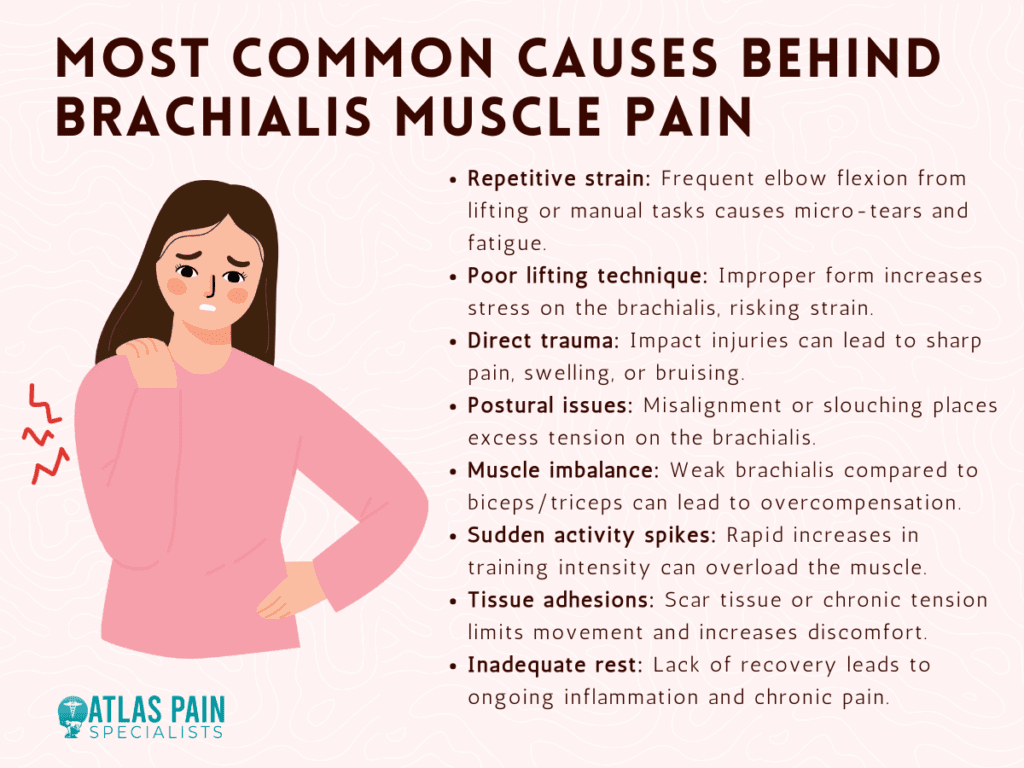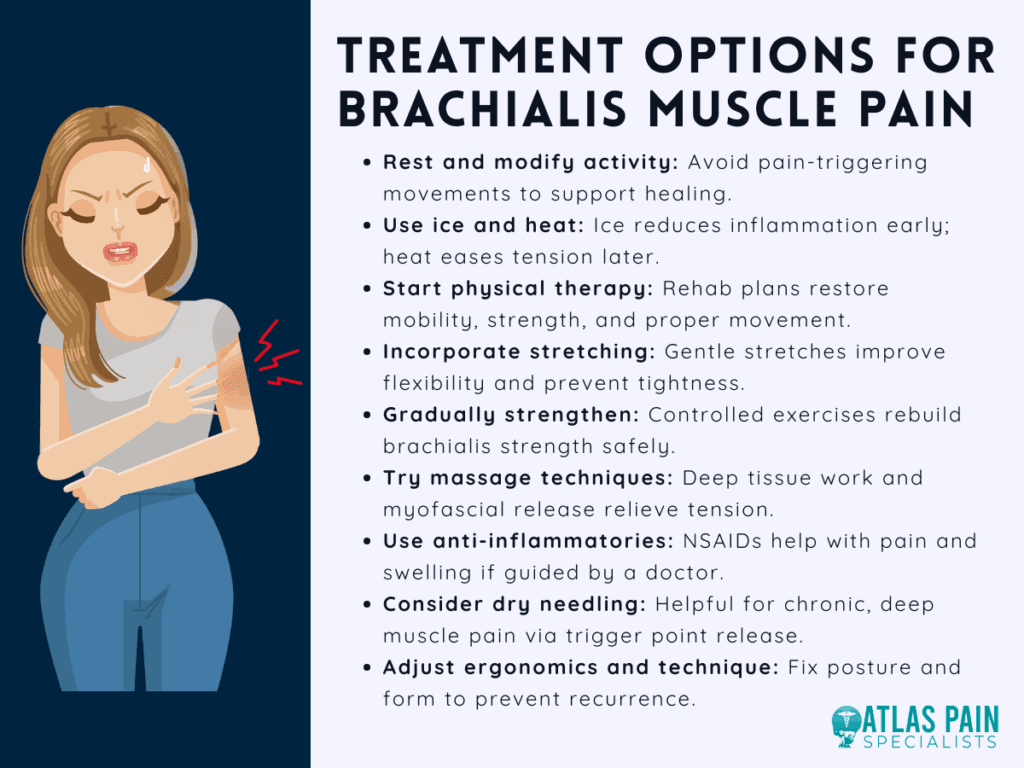

Brachialis Pain: What It Is and How to Treat It
Brachialis pain refers to discomfort or strain in the brachialis muscle—a deep muscle located beneath the biceps in the upper arm. This pain typically results from overuse, poor lifting form, or direct trauma and is often mistaken for biceps or elbow issues.
Treating brachialis pain involves rest, activity modification, ice or heat therapy, physical rehabilitation, and gradual strengthening exercises. Early intervention is key to a full recovery and preventing chronic discomfort.
In this article, you'll learn more about the brachialis muscle and its role in arm movement, along with the common causes and symptoms of brachialis pain. We'll also cover how it's diagnosed, effective treatment options, tips for prevention, and guidance on when to see a doctor for proper care.
What Is the Brachialis Muscle?
The brachialis is a deep muscle located in the upper arm, lying underneath the more prominent biceps brachii. It originates from the lower half of the front of the humerus (upper arm bone) and inserts into the ulna, one of the forearm bones. Unlike the biceps, the brachialis does not cross the shoulder joint and is solely focused on elbow movement.
Its primary function is to flex the elbow, especially when the forearm is in a pronated position (palm facing down). In fact, the brachialis is the strongest elbow flexor, playing a critical role in lifting and pulling motions, even more so than the biceps. Despite its importance, it often goes unnoticed until pain or injury occurs.
What Is Brachialis Pain?
Brachialis pain refers to discomfort, soreness, or tenderness specifically localized within the brachialis muscle. This pain can range from a dull ache to a sharp, stabbing sensation, and may worsen with movement or activity that involves elbow flexion. Due to its deep location, identifying brachialis pain can sometimes be challenging, as it can be mistaken for biceps pain or referred pain from the shoulder or neck.
Common Causes of Brachialis Pain
Brachialis pain can result from a variety of factors, most often related to overuse or mechanical stress placed on the muscle. Below are some of the most common causes that lead to strain or injury in the brachialis.

1. Overuse or Repetitive Strain
Repeated elbow flexion, especially during activities like weightlifting, climbing, or manual labor, can overwork the brachialis muscle. Over time, this continuous strain can lead to micro-tears and inflammation, resulting in deep aching pain and muscle fatigue.
2. Improper Lifting Technique
Using poor form during exercises such as bicep curls or chin-ups can shift unnecessary stress onto the brachialis. Lifting too heavy or performing movements too quickly without control increases the likelihood of straining this deep arm muscle.
3. Direct Trauma or Impact
A fall, collision, or sudden forceful movement can directly injure the brachialis muscle. This can lead to sharp pain, swelling, tenderness, or even bruising, especially if the muscle fibers are torn or compressed.
4. Postural Imbalances
Slouched posture, forward-rounded shoulders, or a misaligned spine can alter the natural position of the arm and shoulder. Over time, this misalignment may increase tension on the brachialis during everyday arm movements, especially in desk-bound individuals or athletes with poor posture habits.
5. Muscle Imbalance
When the biceps or triceps are disproportionately stronger than the brachialis, the smaller muscle may be forced to work harder during elbow flexion. This compensation can overload the brachialis and lead to strain or irritation.
6. Sudden Increase in Activity or Intensity
Jumping into a new workout routine or significantly increasing training intensity without proper progression can shock the brachialis. The muscle may not be conditioned to handle the new load, making it more susceptible to injury.
7. Tendon or Soft Tissue Adhesions
Chronic tension, poor recovery practices, or scar tissue formation around the brachialis can restrict its movement and increase friction during motion. These soft tissue restrictions can cause pain and reduce mobility.
8. Improper Recovery or Lack of Rest
Failing to give the muscle adequate time to rest between workouts or strenuous activities can prevent healing. Over time, this constant stress without recovery may lead to chronic inflammation and pain.
Recognizing the underlying cause of brachialis pain is essential for effective treatment and long-term recovery. Addressing these contributing factors early—through proper technique, balanced training, and recovery—can help prevent chronic discomfort and reduce the risk of future injury.
Symptoms of Brachialis Pain
Brachialis pain often presents subtly and may be mistaken for other arm or elbow issues. Recognizing its specific symptoms can help with early identification and proper treatment.
1. Deep, Aching Upper Arm Pain
A dull ache is usually felt deep beneath the biceps. It often worsens with arm use or after activity.
2. Pain During Elbow Flexion
Bending the elbow, especially with resistance, can trigger discomfort. Pain may be stronger when the palm faces downward.
3. Tenderness to Touch
Pressing on the lower upper arm may feel sore or sensitive. The tenderness is often felt deep under the surface.
4. Weakness in the Arm
Lifting or pulling may feel harder due to reduced strength. This weakness can affect workouts or daily tasks.
5. Muscle Stiffness or Tightness
The arm may feel tight or restricted, especially after rest. Full extension or flexion may be uncomfortable.
6. Radiating Pain Toward the Elbow
Pain can spread down toward the elbow or forearm. This may lead to confusion with joint or nerve problems.
Recognizing these signs early can help prevent further strain or injury. If symptoms persist or worsen, it’s best to consult a healthcare professional.
Diagnosing Brachialis Pain
Accurate diagnosis is key to treating brachialis pain effectively, as it often mimics other arm or elbow conditions. Healthcare professionals use several methods to pinpoint the exact source of discomfort.
- Physical Examination - A doctor checks for tenderness, swelling, and pain during specific arm movements.
- Palpation and Muscle Testing - Gentle pressure and resistance tests help identify weakness or pain in the brachialis.
- Functional Movement Assessment - Watching how the arm moves reveals stress points or compensations.
- Imaging Tests - Ultrasound or MRI may be used to detect inflammation, tears, or rule out other issues.
- Differential Diagnosis - Other conditions like biceps tendonitis or nerve issues are ruled out through comparison.
Early and accurate diagnosis helps guide the right treatment plan and speeds recovery. If pain persists or limits your activities, professional evaluation is recommended.
Effective Treatment for Brachialis Pain
Treating brachialis pain involves a combination of rest, therapeutic techniques, and gradual reconditioning to restore strength and function. Addressing the root cause—whether it's overuse, poor form, or muscle imbalance—is essential for lasting relief. Below are the most effective treatment options:

1. Rest and Activity Modification
The first step in recovery is reducing or avoiding activities that aggravate the pain, such as heavy lifting or repetitive elbow flexion. Giving the muscle time to heal helps prevent further irritation and supports tissue repair.
2. Ice and Heat Therapy
Applying ice packs to the affected area during the first 48–72 hours can reduce inflammation and numb sharp pain. Once the acute phase passes, heat therapy can help relax the muscle, improve circulation, and relieve lingering stiffness.
3. Physical Therapy
A physical therapist can design a tailored rehabilitation program focusing on restoring range of motion, improving muscle balance, and correcting faulty movement patterns. Manual techniques such as soft tissue release may also be used to ease tension in the brachialis.
4. Stretching and Mobility Exercises
Gentle stretches targeting the forearm and upper arm muscles help reduce tightness and improve flexibility. Regular mobility work can prevent scar tissue formation and promote smoother muscle function during healing.
5. Strengthening Exercises
Once pain decreases, gradually reintroducing resistance exercises like hammer curls and reverse curls can help strengthen the brachialis. Starting with light weights and focusing on controlled movements is key to rebuilding endurance without re-injury.
6. Massage or Myofascial Release
Massage therapy, particularly deep tissue or trigger point work, can relieve muscle knots and improve blood flow. Myofascial release techniques target the deeper layers where the brachialis resides, helping to reduce chronic tension.
7. Anti-inflammatory Medications
Over-the-counter NSAIDs such as ibuprofen or naproxen can provide short-term pain relief and reduce swelling. These should be used under the guidance of a healthcare provider, especially if taken for more than a few days.
8. Dry Needling or Trigger Point Therapy
For persistent or chronic brachialis pain, techniques like dry needling may help release tight muscle fibers. These therapies are typically administered by licensed professionals and can be effective in reducing deep muscle pain.
9. Ergonomic and Technique Adjustments
Correcting posture and ensuring proper form during exercise or work tasks is essential to prevent recurrence. This may include adjusting lifting techniques, modifying workstations, or improving arm mechanics during training.
Combining these treatments under professional supervision ensures a comprehensive approach to recovery. With consistent care and attention to proper mechanics, most cases of brachialis pain resolve successfully over time.
When to Seek Medical Attention
While mild brachialis pain often improves with rest and care, some symptoms may signal a more serious issue. Knowing when to seek professional help ensures proper treatment and prevents complications.
- Pain Lasting Over a Week - If discomfort persists despite rest and home care, see a doctor.
- Loss of Strength or Function - Struggling to bend your elbow or grip objects may indicate a deeper injury.
- Visible Swelling or Bruising - These signs could suggest a muscle tear or internal bleeding.
- Numbness or Tingling - These sensations may point to nerve involvement and require evaluation.
- Limited Daily Activity - If pain interferes with routine tasks, professional assessment is needed.
- No Improvement with Treatment - If symptoms don’t improve after self-care, seek medical advice.
Seeing a healthcare provider at the right time can speed recovery and prevent further damage. Don’t ignore persistent or worsening symptoms.
Preventing Brachialis Pain
Preventing brachialis pain involves proper technique, balanced training, and attentive recovery. Here are key strategies to reduce your risk:
- Warm Up Properly - Start all workouts or physical tasks with light cardio and dynamic stretches to prepare the muscles and prevent strain.
- Use Correct Lifting Form - Focus on controlled, well-aligned movements during exercises, especially those involving elbow flexion like curls or rows.
- Progress Gradually - Avoid sudden increases in weight or repetitions. Build strength and endurance slowly to let the brachialis adapt safely.
- Balance Your Workouts - Include exercises for the biceps, triceps, forearms, and shoulders to prevent muscle imbalances that stress the brachialis.
- Stretch and Mobilize - Regular stretching and mobility work helps maintain flexibility and reduces tightness in the upper arm and shoulder region.
- Maintain Good Posture - Keep your shoulders back and arms aligned during daily activities and exercise to reduce unnecessary strain.
- Listen to Your Body - If you feel pain or fatigue, take a break or modify your routine to prevent injury from overuse.
By following these simple steps, you can keep your brachialis healthy, improve arm performance, and avoid pain or injury.
Conclusion: Brachialis Pain – What It Is and How to Treat It
Brachialis pain is a deep, often overlooked source of upper arm discomfort caused by overuse, poor technique, or muscle imbalances. It typically presents as aching pain during elbow flexion and can limit daily function if left untreated.
Fortunately, with proper diagnosis, rest, physical therapy, and gradual strengthening, most cases can be effectively managed or fully resolved. By understanding the brachialis muscle, recognizing symptoms early, and applying the right treatment strategies, individuals can recover safely and prevent future injury.
About Dr. Sean Ormond



